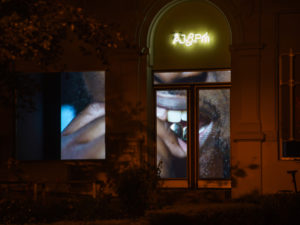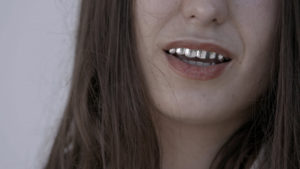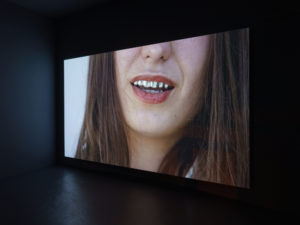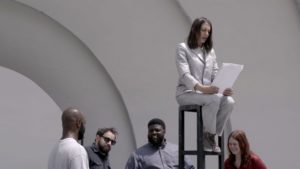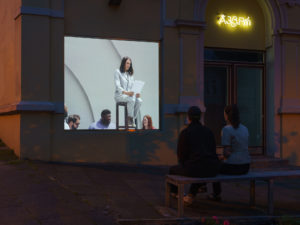15.23
Lili Reynaud-Dewar TEETH GUMS MACHINES FUTURE SOCIETY
TEETH GUMS MACHINES FUTURE SOCIETY
More
Memphis was not only an epicenter of the American slave trade, but it also played a significant role in the later civil rights movement. One of the most notable events in this regard was the sanitation strike of 1968, which was further intensified by the tragic assassination of Martin Luther King Jr. Memphis is also known as a hub of American music history, particularly celebrated for its blues music. It serves as the final resting place of Elvis Presley and has emerged as a vibrant hotspot for the rap and hip-hop music scene.
The video highlights Black music culture as well, specifically in its reference to a cult object known as a “grill” – a gleaming piece of precious metal jewelry worn over the teeth. The grill is regarded not only as a status symbol but also as a relic of rap and hip-hop culture, with its earliest iterations appearing in the early 1980s. The video finds Reynaud-Dewar collaborating with four local comedians, representing both white and people of color, to engage in a provocative discussion on the contentious topic of cultural appropriation surrounding grillz. As a white, European artist, she acknowledges the act of cultural appropriation and deliberately stimulates the pertinent questions and ongoing debates of our time. Close-up shots show the insertion of grillz into the mouth, with both the artist and the comedians sporting a custom-made golden grill. Reynaud-Dewar perceives teeth as an interface, a threshold that bridges the gap between public and private realms of appearance.
A further recurring motif in the video is the presence of trash, which appears in various situations. There are multiple scenes depicting people explicitly throwing garbage on the street, crumpling paper, and animated trash (cans, paper, wrappers, etc.) flying through the city. The motif is a reference to the 1968 sanitation strike in Memphis, where predominantly Black garbage workers went on strike due to extremely low wages and hazardous working conditions. On April 3, 1968, Martin Luther King Jr. delivered his famous speech in support of the strike – tragically, just one day later, King was assassinated in Memphis. Reflecting on this, one interviewee in the video aptly states, “What Memphis has that is unique is failure.” This double metaphor of waste – encompassing both squandered political potential and tangible garbage – symbolically unifies the themes explored in this artwork.
The video culminates in a meticulously staged performance on a shell-shaped concrete stage that, historically, has served as a concert venue for numerous local musicians who later achieved fame. The scattered furniture on the stage bears a strong resemblance to Sol LeWitt’s conceptual abstract sculptures (e.g. Standing Open Structure Black, 1964). Seated on one of these high chairs, a white individual who reads as female recites Donna Haraway’s 1985 socialist-feminist manifesto, “A Cyborg Manifesto.” Simultaneously, four stand-up comedians provide commentary and engage in improvisation, while the polyphonic chorus is accompanied by a sound DJ. The manifesto not only serves as a source of textual material but also as the conceptual framework for the performance and the video itself. In her essay, the author explores the emergence of a new entity she terms a “cyborg,” a fusion of human and machine. Haraway argues that traditional notions of gender, race, and identity are becoming increasingly obsolete as technological progress and scientific advancements blur the boundaries of these categories.
Haraway’s vision considers the cyborg not as a threat but rather as a symbol of hope for a new social order that transcends rejection and exclusion. The artist skillfully intertwines the manifesto in various ways, establishing a connection to the present, also in the year 2023. Firstly, the text serves as a source and is selectively recited during the performance. Secondly, the fundamental ideas of the manifesto permeate the conversations and discussions between the artist and the comedians, delving into the root causes of minority exclusion and other related topics. Lastly, the grillz themselves evoke a futuristic form of body modification, aligning with the tradition of (aesthetic) bodily prosthetics that aim to compensate for and enhance the capabilities of the human body.
As the title TEETH GUMS MACHINES FUTURE SOCIETY suggests, the work presents guidelines for a near future shaped significantly by (AI) machines and new social orders for our globalized world. Through historical references and cultural appropriation of a cult object, the artist establishes a connection to social issues of racism, the exclusion of minorities, and their contemporary implications. Rather than taking a definitive, didactic stance, she examines these phenomena with a touch of humor, creating a sense of detachment that, in turn, challenges viewers take their own position. The artist skillfully composes a constellation of concepts, objects, quotations, and historical references that transcends mere chance. Rather than seek to untangle these intricacies, her intention is to dissolve them through the polyphonic chorus she assembles. Reynaud-Dewar aims to explore points of intersection and create interfaces, tracing the intricate interplay of ideas. In a time where the future seems less utopian than ever, her work encourages critical reflection.
Lili Reynaud-Dewar has developed a complex body of work in recent years that consistently explores concepts of cultural, social, and emotional identity. Through the creation of objects, video installations, films, and magazines (Pétunia), either individually or in collaboration with friends or students, she evokes the spirit of such transgressive figures of twentieth-century cultural production as Josephine Baker, Guillaume Dustan, Bjarne Melgaard, Cosey Fanni Tutti, and Pier Paolo Pasolini. Rather than centering her work around any one subject or debate, Reynaud-Dewar aims to translate social and political questions into the realm of aesthetics, revealing inherent contradictions. Deliberately breaking with conventions and traditions, she examines and challenges them, ultimately fostering a space for contemplation where viewers are compelled to form their own perspectives and interpretations.
Lili Reynaud-Dewar (born in 1975 in La Rochelle, France; currently living and working in Paris and Grenoble) initially studied public law and ballet before pursuing her art education at the École Régionale des Beaux-Arts in Nantes. She completed her Master of Fine Arts degree at the Glasgow School of Art in 2003. It was during this period that she began writing critical texts as well. Reynaud-Dewar’s solo exhibitions and projects have been shown at various prominent venues including Palais de Tokyo in Paris (2023), Musée d’Art Contemporain de Montréal in Canada (2023), Museum für angewandte Kunst in Vienna (2023), Kunsthaus Bregenz (2018), Monash University Museum of Art in Melbourne (2017), Artpace in San Antonio, Texas (2017), Vleeshal in Middelburg, the Netherlands (2017), Museion in Bolzano, Italy (2017), Kunstverein in Hamburg (2016), and Bielefelder Kunstverein (2011). Her works have featured in numerous group exhibitions, including significant biennials such as the 56th Venice Biennale (2015), the Marrakech Biennial (2014), Lyon Biennials (2007/2013), La Triennale at Palais de Tokyo, Paris (2012), and the 5th Berlin Biennale (2008). Together with Dorothée Dupuis and Valérie Chartrain, Reynaud-Dewar is a co-founder and editor of the magazine Pétunia.
The video highlights Black music culture as well, specifically in its reference to a cult object known as a “grill” – a gleaming piece of precious metal jewelry worn over the teeth. The grill is regarded not only as a status symbol but also as a relic of rap and hip-hop culture, with its earliest iterations appearing in the early 1980s. The video finds Reynaud-Dewar collaborating with four local comedians, representing both white and people of color, to engage in a provocative discussion on the contentious topic of cultural appropriation surrounding grillz. As a white, European artist, she acknowledges the act of cultural appropriation and deliberately stimulates the pertinent questions and ongoing debates of our time. Close-up shots show the insertion of grillz into the mouth, with both the artist and the comedians sporting a custom-made golden grill. Reynaud-Dewar perceives teeth as an interface, a threshold that bridges the gap between public and private realms of appearance.
A further recurring motif in the video is the presence of trash, which appears in various situations. There are multiple scenes depicting people explicitly throwing garbage on the street, crumpling paper, and animated trash (cans, paper, wrappers, etc.) flying through the city. The motif is a reference to the 1968 sanitation strike in Memphis, where predominantly Black garbage workers went on strike due to extremely low wages and hazardous working conditions. On April 3, 1968, Martin Luther King Jr. delivered his famous speech in support of the strike – tragically, just one day later, King was assassinated in Memphis. Reflecting on this, one interviewee in the video aptly states, “What Memphis has that is unique is failure.” This double metaphor of waste – encompassing both squandered political potential and tangible garbage – symbolically unifies the themes explored in this artwork.
The video culminates in a meticulously staged performance on a shell-shaped concrete stage that, historically, has served as a concert venue for numerous local musicians who later achieved fame. The scattered furniture on the stage bears a strong resemblance to Sol LeWitt’s conceptual abstract sculptures (e.g. Standing Open Structure Black, 1964). Seated on one of these high chairs, a white individual who reads as female recites Donna Haraway’s 1985 socialist-feminist manifesto, “A Cyborg Manifesto.” Simultaneously, four stand-up comedians provide commentary and engage in improvisation, while the polyphonic chorus is accompanied by a sound DJ. The manifesto not only serves as a source of textual material but also as the conceptual framework for the performance and the video itself. In her essay, the author explores the emergence of a new entity she terms a “cyborg,” a fusion of human and machine. Haraway argues that traditional notions of gender, race, and identity are becoming increasingly obsolete as technological progress and scientific advancements blur the boundaries of these categories.
Haraway’s vision considers the cyborg not as a threat but rather as a symbol of hope for a new social order that transcends rejection and exclusion. The artist skillfully intertwines the manifesto in various ways, establishing a connection to the present, also in the year 2023. Firstly, the text serves as a source and is selectively recited during the performance. Secondly, the fundamental ideas of the manifesto permeate the conversations and discussions between the artist and the comedians, delving into the root causes of minority exclusion and other related topics. Lastly, the grillz themselves evoke a futuristic form of body modification, aligning with the tradition of (aesthetic) bodily prosthetics that aim to compensate for and enhance the capabilities of the human body.
As the title TEETH GUMS MACHINES FUTURE SOCIETY suggests, the work presents guidelines for a near future shaped significantly by (AI) machines and new social orders for our globalized world. Through historical references and cultural appropriation of a cult object, the artist establishes a connection to social issues of racism, the exclusion of minorities, and their contemporary implications. Rather than taking a definitive, didactic stance, she examines these phenomena with a touch of humor, creating a sense of detachment that, in turn, challenges viewers take their own position. The artist skillfully composes a constellation of concepts, objects, quotations, and historical references that transcends mere chance. Rather than seek to untangle these intricacies, her intention is to dissolve them through the polyphonic chorus she assembles. Reynaud-Dewar aims to explore points of intersection and create interfaces, tracing the intricate interplay of ideas. In a time where the future seems less utopian than ever, her work encourages critical reflection.
Lili Reynaud-Dewar has developed a complex body of work in recent years that consistently explores concepts of cultural, social, and emotional identity. Through the creation of objects, video installations, films, and magazines (Pétunia), either individually or in collaboration with friends or students, she evokes the spirit of such transgressive figures of twentieth-century cultural production as Josephine Baker, Guillaume Dustan, Bjarne Melgaard, Cosey Fanni Tutti, and Pier Paolo Pasolini. Rather than centering her work around any one subject or debate, Reynaud-Dewar aims to translate social and political questions into the realm of aesthetics, revealing inherent contradictions. Deliberately breaking with conventions and traditions, she examines and challenges them, ultimately fostering a space for contemplation where viewers are compelled to form their own perspectives and interpretations.
Lili Reynaud-Dewar (born in 1975 in La Rochelle, France; currently living and working in Paris and Grenoble) initially studied public law and ballet before pursuing her art education at the École Régionale des Beaux-Arts in Nantes. She completed her Master of Fine Arts degree at the Glasgow School of Art in 2003. It was during this period that she began writing critical texts as well. Reynaud-Dewar’s solo exhibitions and projects have been shown at various prominent venues including Palais de Tokyo in Paris (2023), Musée d’Art Contemporain de Montréal in Canada (2023), Museum für angewandte Kunst in Vienna (2023), Kunsthaus Bregenz (2018), Monash University Museum of Art in Melbourne (2017), Artpace in San Antonio, Texas (2017), Vleeshal in Middelburg, the Netherlands (2017), Museion in Bolzano, Italy (2017), Kunstverein in Hamburg (2016), and Bielefelder Kunstverein (2011). Her works have featured in numerous group exhibitions, including significant biennials such as the 56th Venice Biennale (2015), the Marrakech Biennial (2014), Lyon Biennials (2007/2013), La Triennale at Palais de Tokyo, Paris (2012), and the 5th Berlin Biennale (2008). Together with Dorothée Dupuis and Valérie Chartrain, Reynaud-Dewar is a co-founder and editor of the magazine Pétunia.
Text Cynthia Krell
Translation Amy Patton
TEETH GUMS MACHINES FUTURE SOCIETY, 2016
HD video, color, sound
35:59 min.
Courtesy of the artist and Layr, Vienna.
Fotodocumentation Felix Hüffelmann
Close
Translation Amy Patton
TEETH GUMS MACHINES FUTURE SOCIETY, 2016
HD video, color, sound
35:59 min.
Courtesy of the artist and Layr, Vienna.
Fotodocumentation Felix Hüffelmann

